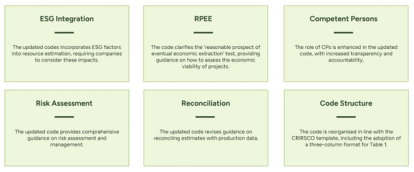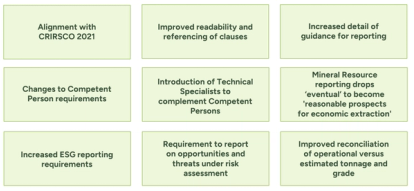
Cultural heritage: Indigenous and cultural heritage values driving sustainable development
by Flavia Kiperman
View post

At a glance:
The JORC updates aim to enhance transparency, incorporate ESG considerations, and improve the reporting of mineral resources and reserves, leading to greater confidence the industry.

The world’s most popular resource and reserve reporting system has released a long-awaited draft update, twelve years after the 2012 edition. The Australian Joint Ore Reserves Committee (JORC) launched the exposure draft of their ‘Australasian Code for Reporting of Exploration Targets, Exploration Results, Mineral Resources, and Ore Reserves’ (the JORC Code) for public consultation in August 2024. Drafting the update has taken an extended period of time due to the number of stakeholders involved, including the Australia Stock Exchange (ASX) and the Australia Securities and Investment Commission (ASIC), along with the Australian Institute of Mining and Metallurgy (AusIMM), exploration and mining companies.
The new document has been drafted following assessment of an external online survey in 2020 and to reflect changes to the minerals and mining sphere since 2012. This includes alignment with the reporting template produced by the umbrella reporting organisation, the Committee for Mineral Reserves International Reporting Standards (CRIRSCO) along with ensuring recent trends – particularly with respect to environmental, social and governance (ESG) - are accounted for. A summary of the key changes from 2012 to 2024 is presented below:

Although there are a number of changes throughout the Code, the purpose of the document remains the same: to ensure mineral companies reporting exploration results, resource and reserve estimates are reporting using the three main principles of transparency, materiality and competence.
As well as providing welcomed clarity for certain aspects and easier general navigation, there are some key changes in the update. Notably, the introduction of Specialists to assist Competent Persons with reporting. Although the Competent Person(s) will remain the main signatory of all public documents using the JORC Code to report against, they now have more structured guidance on how to make use of other technical specialists (also referred to as subject matter experts, SME) where a subject lies outside their field of expertise. This would include roles such as metallurgists, geotechnical engineers, hydrogeologists and ESG specialists.
The increased transparency of ESG issues reflects the recent focus of stakeholders across the board from investors, lenders, consumers, regulators and the public. There is a greater emphasis on ensuring negative impacts associated with minerals and mining projects are assessed at the earliest possible stage with mitigations in place to either avoid and minimise impacts where possible and restore and offset where not possible. Increased transparency in reporting aims to provide potential investors with a complete understanding of the risks to have a well-informed decision.
Although it might seem arbitrary, the removal of the first E from RPEEE (reasonable prospects for eventual economic extraction) to RPEE is significant. In the past, it could give Competent Persons free reign to use pie-in-the-sky economic parameters when assessing the financial prospectivity of the mineral deposit and pushes non-geological considerations to a later stage. Removal of ‘eventual’ brings the mineral resource into the present day. Some may argue it blurs the line with reporting of reserves; however, the fundamental distinction remains, demonstrating technical and economic viability through detailed technical studies to at least a Prefeasibility Study (PFS) level of study. Through considering RPEE, the new Code requires that the Competent Person should assess modifying factors throughout the lifecycle of a project and not just at the reserve reporting stage. This links to the requirement to consider ESG in more depth and at an earlier stage of project development; a key consideration for all stakeholders.
In summary, the draft JORC update brings substantial changes, including ESG considerations, enhanced transparency, and requiring Specialists to assist Competent Persons with the increased reporting expectations.
SLR’s Mining Advisory team can assist minerals and mining companies, with assistance from related technical specialist areas within the SLR Group. This includes:
Technical Expertise:
Experience:
ESG Integration:

by Flavia Kiperman

by Jasper Schrijvers , Matthew Hoare

by Clodagh Connolly, Nicola Inge, Andres Schottlaender